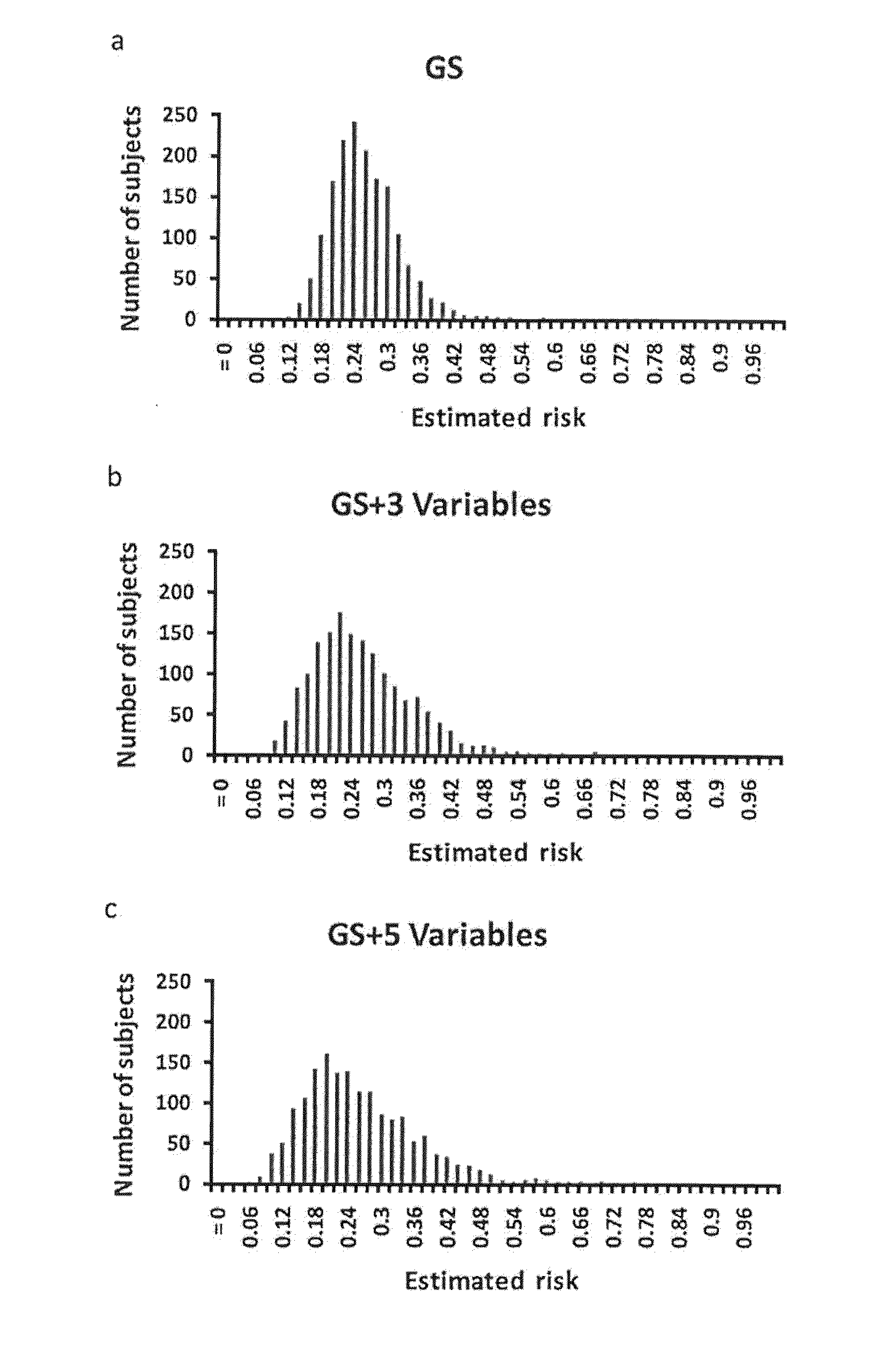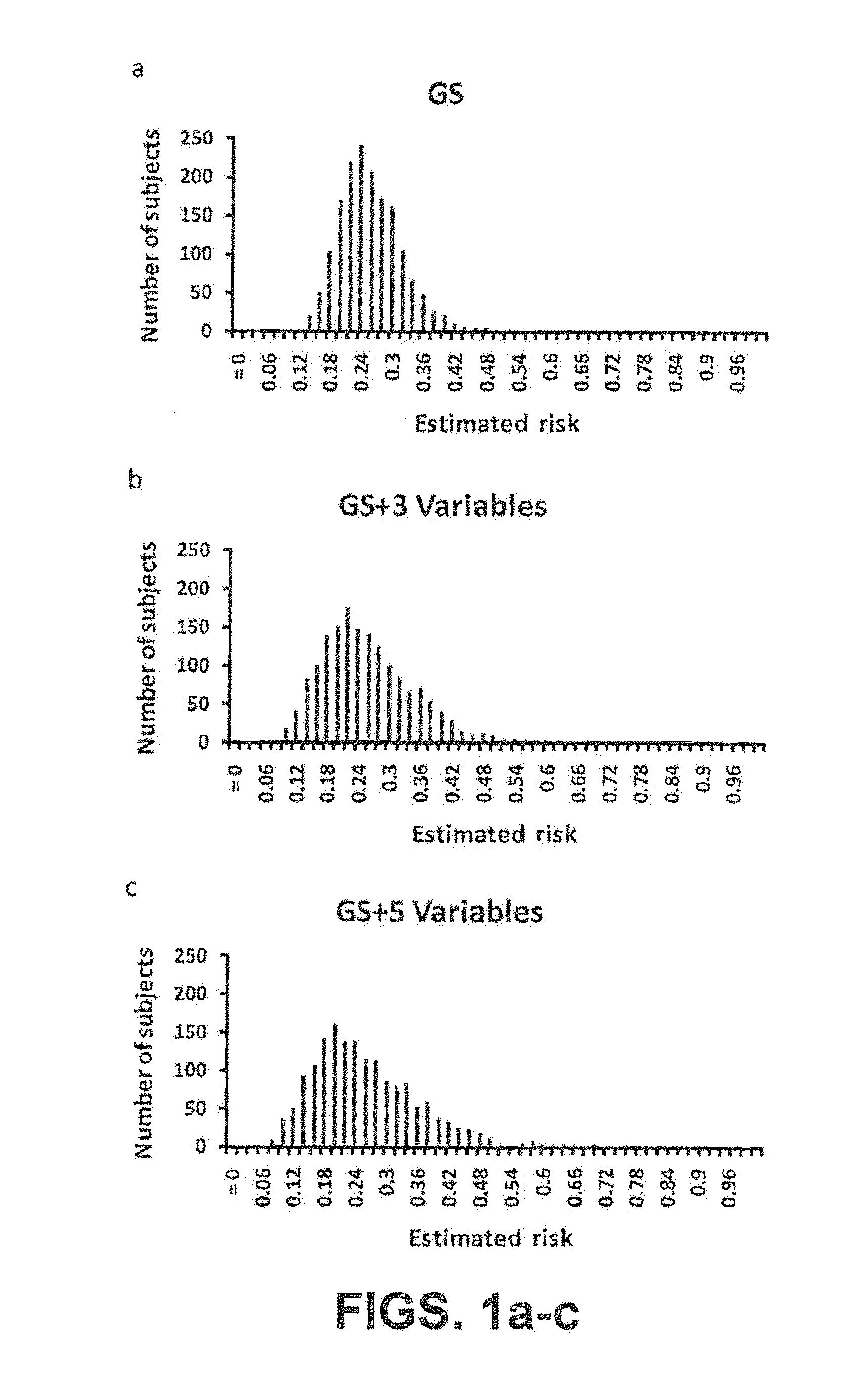Methods and Compositions for Determining Indication for Prostate Biopsy
a technology of prostate biopsy and composition, applied in the direction of instruments, biochemistry apparatus and processes, proteomics, etc., can solve the problems of difficult to predict the outcome of prostate biopsy and difficulty in predicting men at elevated levels
- Summary
- Abstract
- Description
- Claims
- Application Information
AI Technical Summary
Benefits of technology
Problems solved by technology
Method used
Image
Examples
example 1
Methods of Genetic Test to Determine Genetic Score
[0090]In a hierarchical order, three models were used to predict PCa risk. First, a “genetic marker only” model was used in which 33 SNPs identified by genome wide association studies (GWAS) as associated with PCa risk were included. Second, a “genetic marker+pre-biopsy variable model”; in addition to the 33 SNPs, was used. This model included age, family history, and ratio of baseline free PSA to baseline total PSA. Third, a “genetic+pre-biopsy variable+post-biopsy variable model” was used. In addition to the second model, this third model included baseline prostate volume and number of previous biopsy cores. Each model was used to perform risk assessment, which included estimating various measures of PCa risk, including the cumulative relative risk (CRR), percentile risk, absolute risk, and risk score (i.e., the predicted probability of being diagnosed with PCa as determined by a regression model). The predictive performance of eac...
example 2
Clinical Utility of Inherited Genetic Markers for the Prediction of Prostate Cancer at Repeat Biopsy: Results from Placebo Arm of the Reduce® Clinical Trial
[0105]Background.
[0106]The predictive performance of available clinical parameters for prostate cancer (PCa) is limited, particularly following negative prostate biopsy. This study was done to assess the clinical utility of identified PCa risk-associated single nucleotide polymorphisms (SNPs) for PCa prediction in a clinical trial.
[0107]Methods.
[0108]Subjects included 1,654 men who consented for genetic studies in the placebo arm of the randomized REduction by DUtasteride of Prostate Cancer Events (REDUCE) trial, where all subjects had a negative prostate biopsy at baseline and underwent scheduled prostate biopsies at years 2 and 4. Predictive performance of clinical parameters at baseline, and / or a genetic score based on 33 PCa risk-associated SNPs was evaluated using the area under the receiver operating characteristic curve (A...
example 3
Additional Description and Data
[0137]Background of the Problem that is Addressed.
[0138]Prostate cancer (PCa) is the most common solid organ malignancy affecting American men and the second leading cause of cancer related death. There are at least two major problems in diagnosing and preventing PCa: 1) it is difficult to predict men at elevated risk for PCa, and 2) it is difficult to predict outcome of prostate biopsy.
[0139]Recently, 33 PCa risk-associated single nucleotide polymorphisms (SNPs) have been identified. This study was conducted to assess the ability of these 33 inherited PCa risk-associated genetic markers to address the problems listed above.
[0140]Brief Summary of the Invention.
[0141]Using clinical data and DNA samples from the
[0142]REduction by DUtasteride of prostate Cancer Events (REDUCE) trial, results were obtained that may have broad clinical utility:[0143]a) Genetic score based on a panel of 33 PCa risk-associated SNPs (PCS33) can predict an individual's risk for...
PUM
| Property | Measurement | Unit |
|---|---|---|
| threshold | aaaaa | aaaaa |
| threshold | aaaaa | aaaaa |
| threshold | aaaaa | aaaaa |
Abstract
Description
Claims
Application Information
 Login to View More
Login to View More - R&D
- Intellectual Property
- Life Sciences
- Materials
- Tech Scout
- Unparalleled Data Quality
- Higher Quality Content
- 60% Fewer Hallucinations
Browse by: Latest US Patents, China's latest patents, Technical Efficacy Thesaurus, Application Domain, Technology Topic, Popular Technical Reports.
© 2025 PatSnap. All rights reserved.Legal|Privacy policy|Modern Slavery Act Transparency Statement|Sitemap|About US| Contact US: help@patsnap.com



